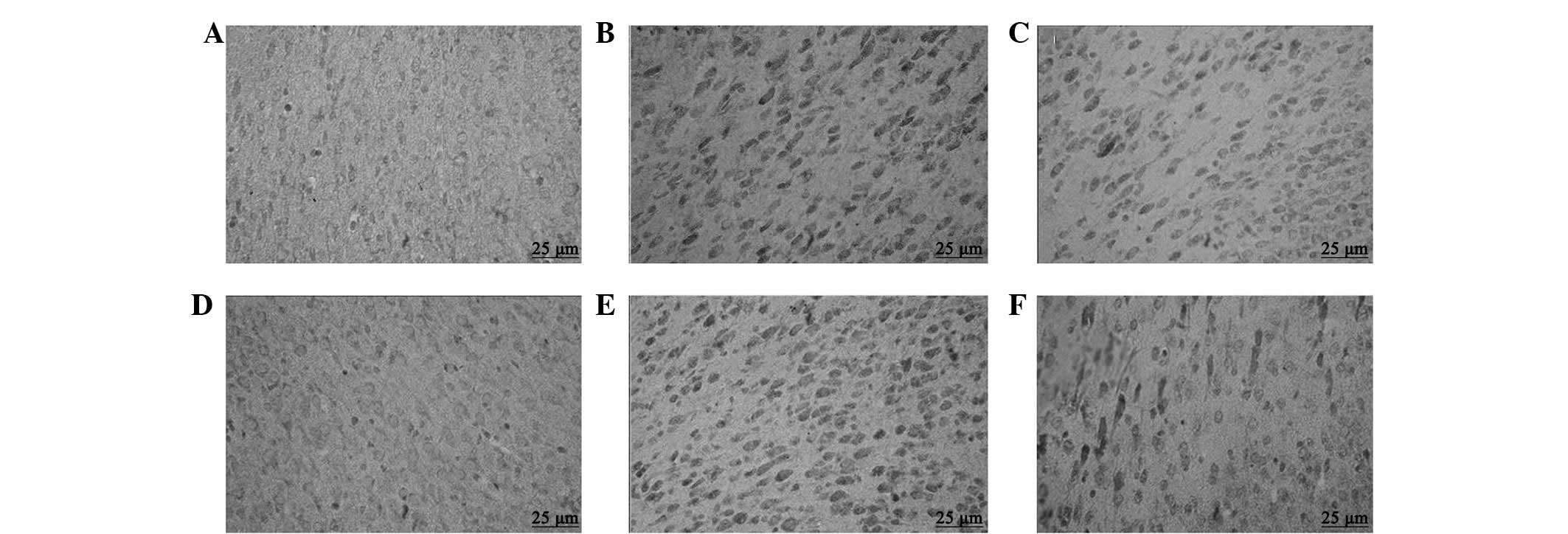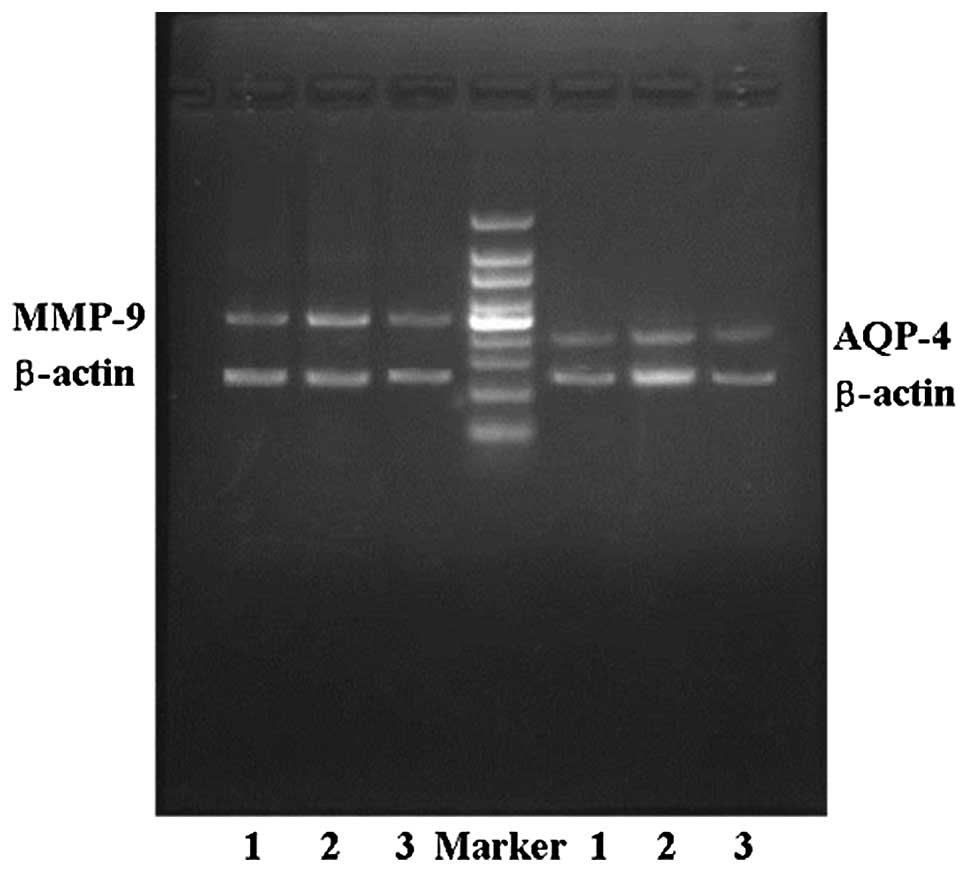|
1.
|
Karasev AV, Lebedev SV, Garats TV,
Sharibzhanova AM, Makarov AV, Volodin NN and Chekhonin VP:
Monitoring of motor disorders in 7-day-old rats with severe
hypoxic-ischemic injury of the brain. Bull Exp Biol Med.
149:677–681. 2010. View Article : Google Scholar : PubMed/NCBI
|
|
2.
|
Boggio PS, Coutinho de Macedo E,
Pascual-Leone A, Tormos Muñoz JM, Schwartzman JS and Fregni F:
Neuromodulation in hypoxic-ischemic injury. Brain Stimul.
2:179–181. 2009. View Article : Google Scholar : PubMed/NCBI
|
|
3.
|
Kaur C, Foulds WS and Ling EA:
Hypoxia-ischemia and retinal ganglion cell damage. Clin Ophthalmol.
2:879–889. 2008. View Article : Google Scholar : PubMed/NCBI
|
|
4.
|
Northington FJ, Chavez-Valdez R and Martin
LJ: Neuronal cell death in neonatal hypoxia-ischemia. Ann Neurol.
69:743–758. 2011. View Article : Google Scholar : PubMed/NCBI
|
|
5.
|
Aly H, Hamed Z, Mohsen L, Ramy N, Arnaoot
H and Lotfy A: Serum amyloid A protein and hypoxic ischemic
encephalopathy in the newborn. J Perina. 31:263–268. 2010.
View Article : Google Scholar : PubMed/NCBI
|
|
6.
|
Doyle OM, Temko A, Murray DM, Lightbody G,
Marnane W and Boylan GB: Predicting the neurodevelopmental outcome
in newborns with hypoxic-ischaemic injury. Conf Proc IEEE Eng Med
Biol Soc. 2010:1370–1373. 2010.PubMed/NCBI
|
|
7.
|
Unterberg AW, Stover J, Kress B and
Kiening KL: Edema and brain trauma. Neuroscience. 129:1021–1029.
2004. View Article : Google Scholar : PubMed/NCBI
|
|
8.
|
Yu L, Yi J, Ye G, et al: Effects of
curcumin on levels of nitric oxide synthase and AQP-4 in a rat
model of hypoxia-ischemic brain damage. Brain Res. 1475:88–95.
2012. View Article : Google Scholar : PubMed/NCBI
|
|
9.
|
Iacovetta C, Rudloff E and Kirby R: The
role of aquaporin 4 in the brain. Vet Clin Pathol. 41:32–44.
2012.PubMed/NCBI
|
|
10.
|
Higashida T, Kreipke CW, Rafols JA, et al:
The role of hypoxiainducible factor-1α, aquaporin-4, and matrix
metalloproteinase-9 in blood-brain barrier disruption and brain
edema after traumatic brain injury. J Neurosurg. 114:92–101.
2011.
|
|
11.
|
Chen G, Shi JX, Qi M, Wang HX and Hang CH:
Effects of progesterone on intestinal inflammatory response, mucosa
structure alterations, and apoptosis. J Surg Res. 147:92–98. 2008.
View Article : Google Scholar : PubMed/NCBI
|
|
12.
|
Stein DG: Progesterone exerts
neuroprotective effects after brain injury. Brain Res Rev.
57:386–397. 2008. View Article : Google Scholar : PubMed/NCBI
|
|
13.
|
Shahrokhi N, Khaksari M, Soltani Z,
Mahmoodi M and Nakhaee N: Effect of sex steroid hormones on brain
edema, intracranial pressure, and neurologic outcomes after
traumatic brain injury. Can J Physiol Pharmacol. 88:414–421. 2010.
View Article : Google Scholar
|
|
14.
|
Kumral A, Ozer E, Yilmaz O, et al:
Neuroprotective effect of erythropoietin on hypoxic-ischemic brain
injury in neonatal rats. Biol Neonate. 83:224–228. 2003. View Article : Google Scholar : PubMed/NCBI
|
|
15.
|
Taniguchi H and Andreasson K: The
hypoxic-ischemic encephalopathy model of perinatal ischemia. J Vis
Exp. 21:9552008.PubMed/NCBI
|
|
16.
|
Wang J, Jiang C, Liu C, Li X, Chen N and
Hao Y: Neuroprotective effects of progesterone following stroke in
aged rats. Behav Brain Res. 209:119–122. 2010. View Article : Google Scholar : PubMed/NCBI
|
|
17.
|
Kasturi BS and Stein DG: Progesterone
decreases cortical and sub-cortical edema in young and aged
ovariectomized rats with brain injury. Restor Neurol Neurosci.
27:265–275. 2009.PubMed/NCBI
|
|
18.
|
Liu B and Arbogast LA: Progesterone
decreases tyrosine hydroxylase phosphorylation state and increases
protein phosphatase 2A activity in the stalk-median eminence on
proestrous afternoon. J Endocrinol. 204:209–219. 2010. View Article : Google Scholar
|
|
19.
|
Tomassoni D, Bramanti V and Amenta F:
Expression of aquaporins 1 and 4 in the brain of spontaneously
hypertensive rats. Brain Res. 1325:155–163. 2010. View Article : Google Scholar : PubMed/NCBI
|
|
20.
|
Lee K, Lee JS, Jang HJ, et al: Chlorogenic
acid ameliorates brain damage and edema by inhibiting matrix
metalloproteinase-2 and 9 in a rat model of focal cerebral
ischemia. Eur J Pharmacol. 15:89–95. 2012. View Article : Google Scholar : PubMed/NCBI
|
|
21.
|
Manley GT, Fujimura M, Ma T, et al:
Aquaporin-4 deletion in mice reduces brain edema after acute water
intoxication and ischemic stroke. Nat Med. 6:159–163. 2000.
View Article : Google Scholar : PubMed/NCBI
|
|
22.
|
Xu M, Su W and Xu QP: Aquaporin-4 and
traumatic brain edema. Chin J Traumatol. 13:103–110.
2010.PubMed/NCBI
|
|
23.
|
Verkman AS, Yang B, Song Y, Manley GT and
Ma T: Role of water channels in fluid transport studied by
phenotype analysis of aquaporin knockout mice. Exp Physiol.
85:233–241. 2000. View Article : Google Scholar : PubMed/NCBI
|
|
24.
|
Yang Y, Estrada EY, Thompson JF, Liu W and
Rosenberg GA: Matrix metalloproteinase-mediated disruption of tight
junction proteins in cerebral vessels is reversed by synthetic
matrix metalloproteinase inhibitor in focal ischemia in rat. J
Cereb Blood Flow Metab. 27:697–709. 2007.
|
|
25.
|
Gidday JM, Gasche YG, Copin JC, et al:
Leukocyte-derived matrix metalloproteinase-9 mediates blood-brain
barrier breakdown and is proinflammatory after transient focal
cerebral ischemia. Am J Physiol Heart Circ Physiol. 289:H558–H568.
2005. View Article : Google Scholar
|
|
26.
|
Tu XK, Yang WZ, Liang RS, et al: Effect of
baicalin on matrix metalloproteinase-9 expression and blood-brain
barrier permeability following focal cerebral ischemia in rats.
Neurochem Res. 36:2022–2028. 2011. View Article : Google Scholar : PubMed/NCBI
|
|
27.
|
Fujimoto M, Takagi Y, Aoki T, et al:
Tissue inhibitor of metalloproteinases protect blood-brain barrier
disruption in focal cerebral ischemia. J Cereb Blood Flow Metab.
28:1674–1685. 2008. View Article : Google Scholar : PubMed/NCBI
|












